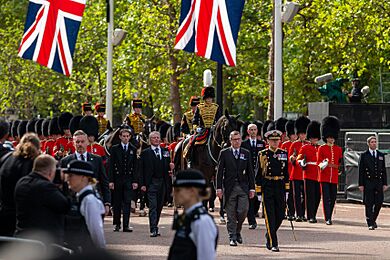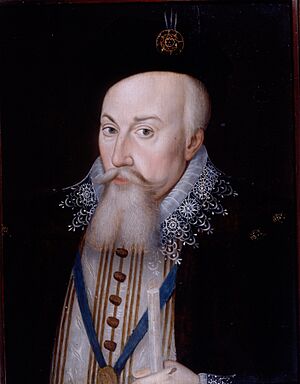Lord Steward facts for kids

The Lord Steward or Lord Steward of the Household is a very important role in the Royal Household of the British monarch. It is one of the three main "Great Officers" who help run the royal household. This person is traditionally seen as the most important of these officers. People who hold this job are always peers, which means they are members of the nobility, like dukes or earls.
Until 1924, the Lord Steward was always part of the government. Before 1782, this job was very powerful in politics, even being part of the King's top team, known as the Cabinet. The Lord Steward used to lead a group called the Board of Green Cloth. This group handled many things for the royal household. However, the Board of Green Cloth stopped existing in 2004.
In the 1920s, the role of Lord Steward changed. It became more of an honorary title. Most of the daily tasks and management that the Lord Steward once did are now handled by the Master of the Household. The Master of the Household is a full-time staff member who lives at the palace. Even though the job is mostly honorary now, the Lord Steward still attends important royal events. These include State visits, big banquets, the opening of Parliament, State Funerals, and Coronations.
The King or Queen personally chooses the Lord Steward. The person chosen carries a white staff. This staff is a symbol of their power and authority. The current Lord Steward, appointed in 2023, is the Earl of Rosslyn.
Contents
A Look Back: The Lord Steward's History

The Lord Steward's role has a long and interesting history. In the past, this job was much more hands-on and powerful.
Managing the Royal Household
Historically, the Lord Steward was in charge of everything "Below Stairs" in the royal household. This meant they managed all the servants and daily operations. An old law from 1539 described the Lord Steward as the "grand master" of the King's household.
Most of the day-to-day management was done by the Board of Green Cloth. This Board included other important people like the Treasurer of the Household and the Comptroller of the Household. It also had the Cofferer of the Household, who managed the money. Many clerks helped with the daily running of the household. These clerks worked closely with the Lord Steward.
The "Below Stairs" departments were mostly about food and drink. This included the royal kitchens and wine cellars. There were also places like the buttery (for drinks), spicery (for spices), and bakehouse (for baking). Each of these had its own staff. Over time, especially in the 1700s and 1800s, many of these smaller departments closed. The royal household started buying more things from outside suppliers.
The Lord Steward as a Judge
The Lord Steward also acted as a main judge. They handled all crimes and legal issues that happened within the "Verge" of the Royal Court. The Verge was a special area around wherever the King or Queen was staying. The Lord Steward would sit in special courts, like the Marshalsea Court. The Board of Green Cloth also worked as a lower court for the Verge. The Knight Marshal and the Coroner of the Verge helped the Lord Steward with these legal duties.
Helping Parliament
In earlier times, the Lord Steward or their helpers had a role in Parliament. They used to give the oaths (special promises) to the members of the House of Commons. During the Tudor period, the Lord Steward was responsible for checking the list of all the elected members of Parliament before each State Opening. Also, if the King or Queen sent a message to Parliament, the Lord Steward was one of the people who would deliver it.
Past Lord Stewards
Here is a list of some of the people who have held the important role of Lord Steward over the centuries.
15th century
- Sir Thomas Rempston 1399–1401
- Thomas Percy, 1st Earl of Worcester 1401–1402
- William Heron, Lord Say 1402–1404
- Sir Thomas Erpingham 1404
- Sir John Stanley 1405–1412
- Sir Thomas Erpingham 1413–1417
- Sir Walter Hungerford 1413–1421
- Robert Babthorp 1421–1424
- Sir Walter Hungerford 1424–1426
- Sir John Tiptoft 1426–1432
- Robert Babthorp 1432–1433
- William de la Pole, 1st Marquess of Suffolk 1433–1446
- Ralph Boteler, 1st Baron Sudeley 1447–1457
- John Beauchamp, 1st Baron Beauchamp 1457–1461
- William Neville, 1st Earl of Kent 1461–1463
- John Tiptoft, 1st Earl of Worcester 1463–1467
- Henry Bourchier, 1st Earl of Essex 1467–1471
- Thomas Stanley, 2nd Baron Stanley 1471–1483
- Thomas Howard, Earl of Surrey 1483–1485
- John Radcliffe, Baron FitzWalter 1486–1496
- Robert Willoughby, 1st Baron Willoughby de Broke 1496–1502
16th century
- George Talbot, 4th Earl of Shrewsbury 1502–1538
- Robert Radcliffe, 1st Earl of Sussex 1538–1540
- Charles Brandon, 1st Duke of Suffolk 1540–1545
- William Paulet, Lord St John 1545–1550
- John Dudley, 1st Earl of Warwick 1550–1553
- Henry Fitzalan, 12th Earl of Arundel 1553–1564
- Vacant 1564–1567
- William Herbert, 1st Earl of Pembroke 1567–1570
- Vacant 1570–1572
- Edward Fiennes, Earl of Lincoln 1572–1584
- Robert Dudley, 1st Earl of Leicester 1584–1588
- Henry Stanley, Earl of Derby 1588–1593
- Vacant 1593–1597
17th century
- The Earl of Nottingham 1603–1618
- The Duke of Richmond 1618–1623
- The Marquess of Hamilton 1623–1625
- The Earl of Pembroke 1625–1630
- Vacant 1630–1640
- The Earl of Arundel and Surrey 1640–1644
- The Duke of Richmond 1644–1655
- Vacant 1655–1660
- The Duke of Ormonde 1660–1688
- The Duke of Devonshire 1689–1707
18th century
- The Duke of Devonshire 1707–1710
- The Duke of Buckingham and Normanby 1710–1711
- The Earl Poulett 1711–1714
- The Duke of Devonshire 1714–1716
- The Duke of Kent 1716–1718
- The Duke of Argyll 1718–1725
- The Duke of Dorset 1725–1730
- The Earl of Chesterfield 1730–1733
- The Duke of Devonshire 1733–1737
- The Duke of Dorset 1737–1744
- The Duke of Devonshire 1744–1749
- The Duke of Marlborough 1749–1755
- The Duke of Rutland 1755–1761
- The Earl Talbot 1761–1782
- The Earl of Carlisle 1782–1783
- The Duke of Rutland 1783
- The Earl of Dartmouth 1783
- The Duke of Chandos 1783–1789
- The Duke of Dorset 1789–1799
- The Earl of Leicester 1799–1802
19th century
- The Earl of Dartmouth 1802–1804
- The Earl of Aylesford 1804–1812
- The Marquess of Cholmondeley 1812–1821
- The Marquess Conyngham 1821–1830
- The Duke of Buckingham and Chandos 1830
- The Marquess Wellesley 1830–1833
- The Duke of Argyll 1833–1834
- The Earl of Wilton 1835
- The Duke of Argyll 1835–1839
- The Earl of Erroll 1839–1841
- The Earl of Liverpool 1841–1846
- The Earl Fortescue 1846–1850
- The Marquess of Westminster 1850–1852
- The Duke of Montrose 1852–1853
- The Duke of Norfolk 1853–1854
- The Earl Spencer 1854–1857
- The Earl of St Germans 1857–1858
- The Marquess of Exeter 1858–1859
- The Earl of St Germans 1859–1866
- The Earl of Bessborough 1866
- The Duke of Marlborough 1866–1867
- The Earl of Tankerville 1867–1868
- The Earl of Bessborough 1868–1874
- The Earl Beauchamp 1874–1880
- The Earl Sydney 1880–1885
- The Earl of Mount Edgcumbe 1885–1886
- The Earl Sydney 1886
- The Earl of Mount Edgcumbe 1886–1892
- The Marquess of Breadalbane 1892–1895
- The Earl of Pembroke 1895–1905
20th century
- The Earl of Liverpool 1905–1907
- The Earl Beauchamp 1907–1910
- The Earl of Chesterfield 1910–1915
- The Viscount Farquhar 1915–1922
- The Earl of Shaftesbury 1922–1936
- The Duke of Sutherland 1936–1937
- The Duke of Buccleuch 1937–1940
- The Duke of Hamilton 1940–1964
- The Duke of Westminster 1964–1967
- The Viscount Cobham 1967–1972
- The Duke of Northumberland 1973–1988
- The Viscount Ridley 1989–2001
21st century
- The Duke of Abercorn 2001–2009
- The Earl of Dalhousie 2009–2023
- The Earl of Rosslyn 2023–present

